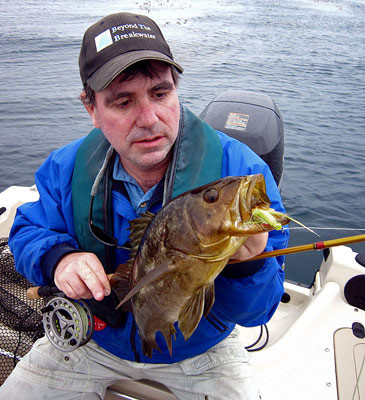San Diego Inshore Saltwater Fly Fishing
Along the San Diego County coastline are miles of extensive kelp forests that are the home of numerous species that make their home within the kelp. Among those species are baitfish that attract migrating pelagic species. The biological richness of this environment produces fantastic saltwater angling opportunities for the fly angler. The prime seasons for Southern California inshore fly fishing are late spring through early fall.

The most sought after gamefish here are the yellowtail and the kelp bass, commonly called the “calico” bass by Southern California anglers. Yellowtail can be very challenging to take on artificial offerings at the depths easily reached with fly tackle, but under the right conditions they are accessible and once hooked can punish the angler and their tackle. The calico bass is most often found in and around the kelp forest and around rocky structure and will rise to topwater presentations as well as inhale subsurface offerings. Other species available to the inshore fly angler include bonito, mackerel, barracuda, white seabags, various rockfish, and sand bass.
Recommended tackle for inshore angling includes 7wt to 10wt rods and reels with a good drag and a backing capacity of at least 100 yards (200 for yellowtail). Floating and intermediate fly lines are useful for surface and near surface presentations with topwater flies and streamers. Lines formulated for tropical conditions are not recommended as they can be difficult to handle in the cool ocean water. Sinking fly lines will be used most often and in most cases the faster the sink rate the better. For topwater presentations most anglers use a 7.5 to 8 foot tapered leader with a 12 to 20 pound tippet. Many anglers make simple two step tapered leaders consisting of a 40 or 50 pound mono butt section of four or five feet in length and loop a tippet section to that. For presentations with sinking lines a simple four to eight foot length of monofilament (either nylon or flourocarbon) is all that is needed. For the toothy barracuda a bite tippet of heavy monofilament or wire will help stay connected to the fly; however, it is sometimes necessary to forego the bite tippet to get bit when the fish are finicky.

There are hundreds of fly patterns available that imitate baitfish and squid and almost all of them will work. The size and color of the offering is usually more important than the specific pattern. As a general rule of thumb use darker colored patterns in low light and brighter patterns under brighter conditions.

When fishing in and around the kelp forest and in rocky structure flies with weed or snag guards will keep more flies on your tippet rather than hung up in kelp or rocks. If you buy flies options may be limited but if you know fly tyer they may be able to incorporate a guard into a factory finished pattern for you. While many patterns are available in shops and catalogs, it is difficult to go wrong with a selection of Clouser minnows and and Lefty’s Deceivers ranging from two to six inches in length tied on size 2 through 3/0 hooks. A basic set of colors would include chartreuse/white, blue/white, olive(or green) /white, orange/yellow ( a favorite for calico bass) and all white. For topwater a few crease flies along with some type of foam popper should be in your fly box. Topwater offerings should be between two and six inches in length.



